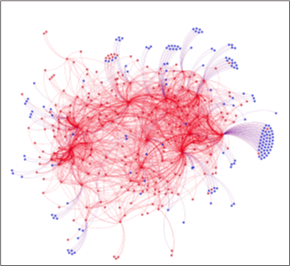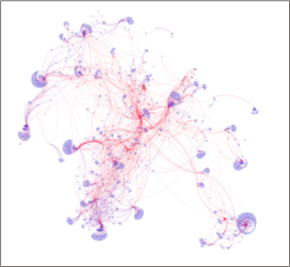by Zach Gentry – Concert CEO
Collaboration within design and construction teams could be infinitely better, and the players have been insulated for so long from other industries that they may not even recognize the deficiency. To clarify the difference, here’s a data-sharing comparison between software and construction. The lines represent data exchanges between internal (red) and external (blue) teams, and the edge weight of the lines represents the frequency:


Data Map 1 – Software Data Map 2 – Construction
(Source: Box.com: The Information Economy, A Study of Five Industries, 2014)
Software teams cross geographies, include multiple stakeholders and acquire data from third-party sources. Yet data flows fluidly, quickly, richly, and progressively. Moreover, in software, all parties usually write to the same place, usually GitHub or some other common medium.
Design and construction are entirely different.
In the current model, architects, owners, and contractors maintain separate logs of shared activities. The architect sends usually sends data via in Project Information Management System and contractors typically return data through their Project Management Information System. Rarely do they use the same system, even when one party grants logging access to the other. That’s because data ownership enables the owner to revoke access, potentially leaving the non-owner without adequate access to the log of activities and information. This leaves us with a suboptimal but deemed adequate outcome in which each party maintains its logs and, therefore, its version of the truth.
Maintaining separate logs of shared information is wrong for four primary reasons.
- Impoverished Collaboration: When there is no shared medium for exchanging information. The project team is left with poor interactions. This lack of collaboration often results in miscommunication, misunderstandings, and inefficiencies that can delay projects and increase costs.
- Bad Data: When multiple, disconnected versions of the files fly around at construction speed, there is an absolute certainty that some of the information is wrong. This can lead to errors and mistakes that can be costly to fix, resulting in project delays and increased costs. According to Autodesk, the global estimate for this issue is $1.8 trillion.
- Risky: Data logging aims to assure your firm’s version of the truth in the case of a claim. However, the presence of multiple, potentially contradictory sources of truth ensures the opposite. According to professional liability insurance carriers, one-third of the cost of a claim is discovery. Your insurance carrier will not likely go to court for you, preferring to pay a claim rather than the costs of a lawsuit. In other words, you could have been meticulous in your record-keeping and project execution and still foot a disproportionate share of the blame. Bad data and poor communication will result in more claims than incorrect or data with mistakes.
- Not Future-Forward: The perpetuation of this system is preventing your firm from reaching its potential. We all want to reduce risks, but we also want to increase our earning capacity, improve our services, and potentially open new sources of revenue. This simply cannot be done when the process is trapped in data silos.
To solve these problems, Concert created a unified logging system. We record every shared project file’s sender, recipient, and digital fingerprints. This is not stored with a data owner, as happens in other systems. Instead, Concert creates an immutable, transparent, and permanent record on a blockchain. These records are stored across thousands of independent computers, assuring no dependency on a single centralized authority. If any computer has even a single digit of variance from the others, the record would be considered unacceptable. This method of data capture has now proven out over billions of transactions and trillions of dollars. It is the only data method for unifying the fractured world of design & construction.
The time to use Concert is not when you can convince an entire construction team to adopt it. Rather, take the initiative today and let your contractor catch up to your improved document management practices. We’ve been quietly growing our project base over the last year and now manage over 300 projects across many firms. We look forward to helping you.





